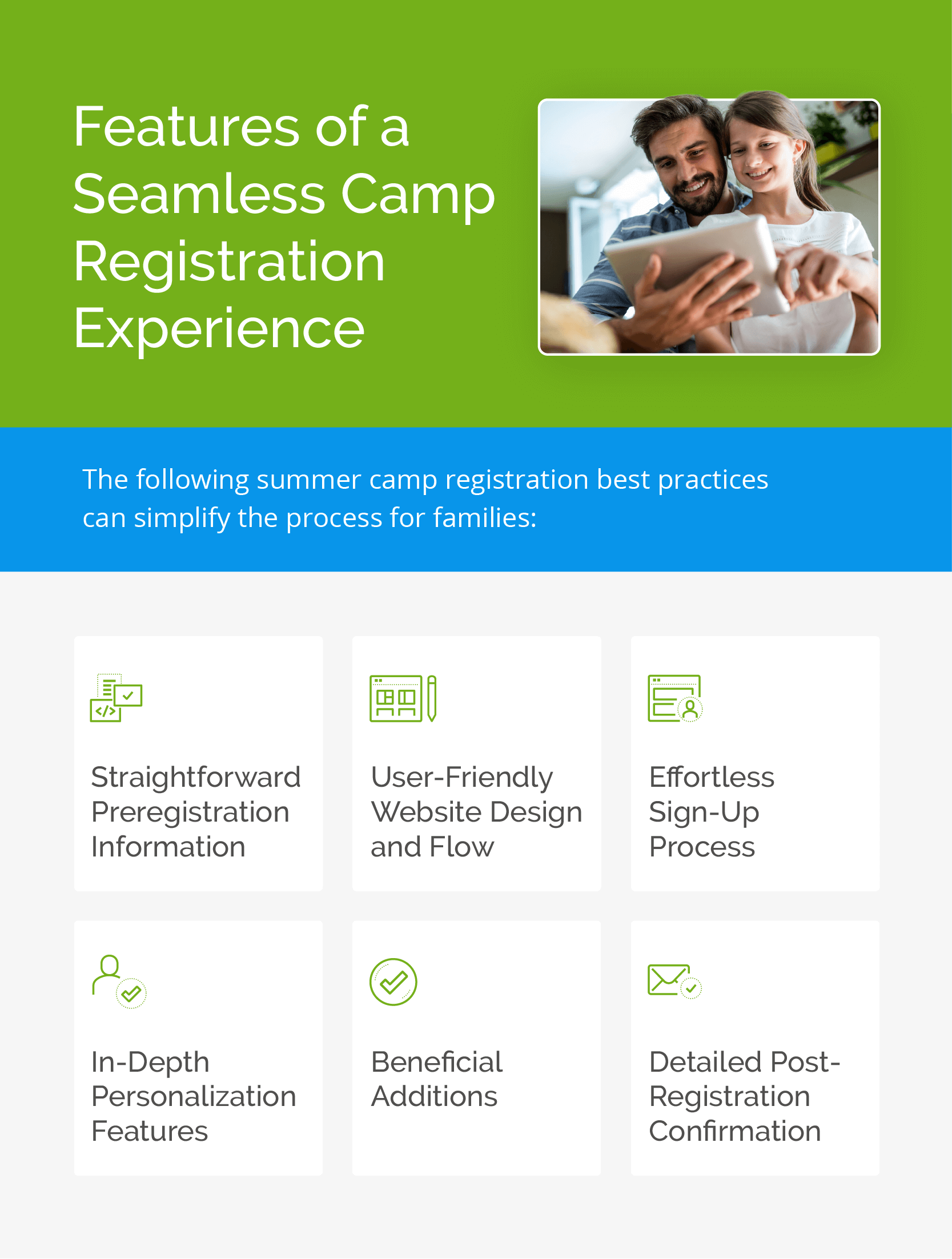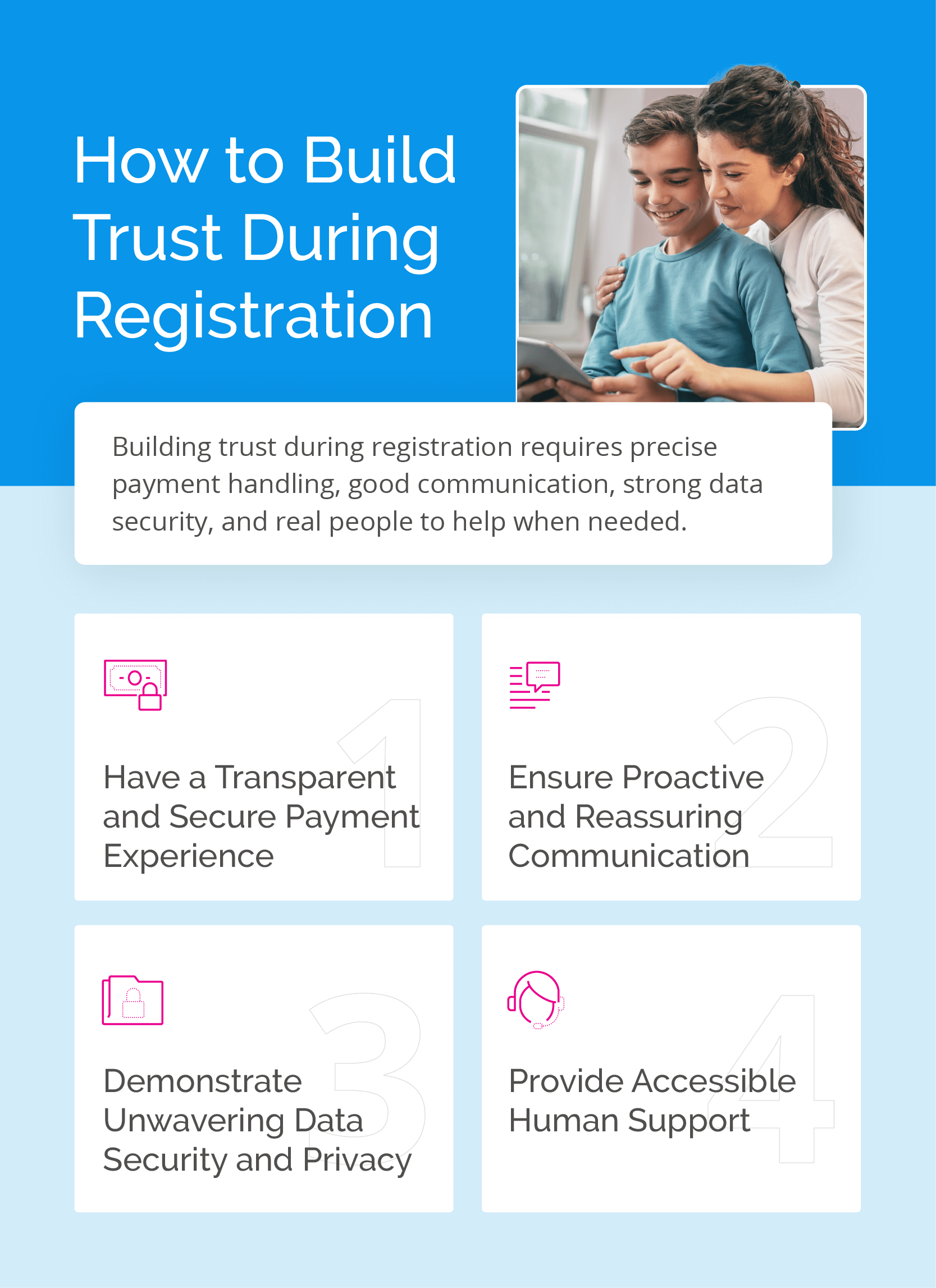Every summer, millions of families take the first step with a camp or program by signing up online. This initial experience shapes their thoughts about your camp or program. It builds trust and often determines whether a family finishes signing up or abandons the process.
People expect smooth online experiences. Outdated registration systems with paper forms, confusing portals, and too many steps create major problems. They lead to lost sign-ups and create administrative headaches throughout the camp season.
Running a camp or any children’s program means competing for families’ attention and trust. When your sign-up process is complicated, families often choose other camps instead. Regpack‘s comprehensive guide helps you understand how to make your camp registration process modern and easy to use.
Why Does the Registration Experience Matter?
The registration experience influences how many families sign up for your program. It also affects how smoothly your camp runs, how much money you make, and what people think about your camp.
It Sets the Tone for the Parent-Camp Relationship
A smooth sign-up process tells parents that your camp is well-run and respects their time. Based on this first interaction, parents judge your camp’s ability to care for their children. Families trust your camp more when they find clear information and straightforward processes.
Parents must share private information during registration, including personal details, health information, and payment data. A safe, trustworthy process is crucial when handling such important details. Parents who face problems or worry about safety during registration often wonder if the camp or program that can’t handle basic tasks can keep their child safe.
It Impacts Enrollment and Retention
Complicated sign-up processes lead to lost campers. Many people won’t return to your form if they encounter problems. If they can’t save progress, the pages take a long time to load, or they experience other complications, they will close the tab and forget the registration process.
A positive first experience helps encourage loyal, returning families. Camps that simplify their registration process report higher completion rates, less administrative work for staff, and fuller camps. Modern camp registration systems help manage waiting lists, price levels, and session choices. They help camps make more money while giving families a better experience.
It Allows for Efficient Staff and Resource Planning
Information from registration helps camps plan for a great summer. Knowing exactly how many campers are coming allows you to plan the right number of staff for each group and program. Details about food needs, health concerns, and activity choices help you order the right supplies and prepare your staff before campers arrive.
Good online registration software turns enrollment data into useful planning tools. Before they arrive, you can put campers into the right groups based on age or skill level, eliminating first-day chaos and letting activities flow smoothly. Planning makes everything run better and gives campers a better experience.
It Streamlines Financial Management
A streamlined registration system makes handling money much easier through automatic features. Automated payment plans and reminder systems reduce payment collection work, freeing staff to focus on running excellent programs instead of chasing payments. Live reports show how much money is coming in and the payment status of enrolled campers.
Built-in payment processing stops errors and makes bookkeeping simpler. Camps using advanced systems report fewer payment questions from parents, faster processing, and better ability to predict income. These improvements help camps make more money and reduce stress.
It Reflects the Camp’s Brand and Values
Your registration process better reflects your camp’s values than any advertisement. An easy, welcoming process that works for everyone shows you care about serving all families. Camps that make sign-up easy show they value families’ time and understand what modern families expect.
What Are the Features of a Seamless Camp Registration Experience?
A fantastic camp registration experience includes many moving parts. It requires careful attention to preregistration information, website design, sign-up processes, personalization features, add-ons, and post-registration confirmation. The following summer camp registration best practices can simplify the process for families:

1. Straightforward Preregistration Information
Preregistration preparation is the foundation of a successful sign-up process. You need to give families clear information about the program, helping them feel confident about registration. Here’s what you should provide:
- Clear and accessible information: Include all essential details families need. Outline exact dates, full prices with no hidden costs, daily schedules for each age group, and information about your staff’s training. Many parents are concerned about their children’s safety at camps, so being open about your camp’s safety rules and staff qualifications helps build trust.
- A proactive FAQ section: Build a helpful FAQ page that answers everyday parent worries. Sort questions into groups like safety rules, health and sanitation, daily activities, what to bring, how you communicate with parents, and refund policies. Update this section based on real questions from parents to keep it helpful and complete.
- Obvious and encouraging calls to action (CTAs): Put clear “Register Now” or “Start Your Application” buttons where families can easily see them on your website. Use friendly words that encourage action while staying welcoming. Place CTA buttons at the top and bottom of important information so families can click when ready.
- Social proof and testimonials: Show real quotes, stories, and reviews from past camp families where everyone can see them. Include specific details about positive experiences and what kids gained from camp. Video reviews work exceptionally well, as Forbes reports that 72% of people trust a company more if they watch positive video testimonials.
2. User-Friendly Website Design and Flow
How your registration website looks and works affects whether families finish signing up. Make sure your site includes these essential elements:
- Mobile-first, responsive design: Many people start and complete forms on their phones since it’s quick and convenient. Your whole website and sign-up system must work perfectly on all devices. When mobile sites don’t work well, most people give up, making responsive design critical.
- Intuitive navigation and clean layout: Create a simple, uncluttered website structure that naturally guides parents to registration. Use clear menu names, organize pages logically, and make the search icon easy to find. Minimize the number of clicks needed to reach registration information, aiming for three or fewer clicks from any page to the sign-up form.
- Consistent and professional branding: Keep the same look with your logo, colors, fonts, and messages from the main website through registration. This consistency builds trust and prevents families from feeling lost.
- Fast page load speeds: If a page takes even one extra second to load, many people abandon it. Make images smaller but still visible, reduce extra code, and use content delivery networks to make sure pages load within two to three seconds. Test your speed often to prevent families from getting frustrated and choosing other camps.
3. Effortless Sign-Up Process
How your registration form works determines whether interested families finish signing up or abandon it. Build your form with these proven methods:
- Logical flow with progress indicators: Break registration into small sections like parent information, camper details, choosing sessions, and payment. Show a progress bar so families know where they are and how much is left. This approach makes the form feel easier and can increase completion.
- Clear program and session selection: Make choosing programs and sessions simple and clear. Show which spots are open to prevent disappointment. Use picture calendars for picking dates. In the selection area, give full descriptions of each session, including activities, age requirements, and what kids need to know.
- “Save and return” functionality: Respect that parents are busy by letting them save their progress without making an account. If they create an account, send email reminders with links to continue where they left off. This feature can recover otherwise abandoned registrations by accommodating interrupted sessions.
- Integrated digital waivers and e-signatures: Eliminate printing, scanning, and mailing by building electronic signatures into your sign-up process. Show forms and policies as part of the normal flow, not as surprises at the end. Clear formatting and simple language help more families complete these requirements without worry.
- A single, secure payment gateway: Let families pay within your registration system instead of sending them to a confusing outside website. Show security badges and explain how payments are protected. Since extra costs are a common reason people abandon forms, show all fees before the payment step.
- Dedicated medical and health information section: Create a safe space that follows HIPAA rules where families can highlight critical medical information. Have detailed spots for allergies, medicines, food needs, behavior notes, and health conditions. Show follow-up questions based on what parents select.
4. In-Depth Personalization Features
Making the process personal shows families that your camp cares about their needs and remembers them from year to year. You can create a personalized camp registration process through the following:
- Smart forms with conditional logic: Use forms that change based on what families select. Hide questions that don’t apply, show age-appropriate choices, and change fields based on which program they pick. For example, day camp families don’t need overnight questions, while special programs might ask about skill levels.
- Prefilled information for returning families: Your camp registration system should automatically populate known information for returning users, like parent names, addresses, or camper details that don’t change. This personalization lets them update what’s new and saves time, showing returning families you value them.
- Household accounts for family management: Build your system for larger families, not only individual campers. Allow parents to manage multiple kids, sign up for different sessions, and see all their camp history in one place. Give families one dashboard showing all registrations, payments, and important dates together.
5. Beneficial Additions
Adding thoughtful extras to your registration can increase value, bring in more money, and help your camp run better. Consider including these helpful options:
- Early bird options: Create exciting early-bird deals that reward families who plan ahead. Show real benefits like lower prices, first choice of sessions, free camp T-shirts, special activities, or discounts at partner stores. Use countdown timers and “limited spots” messages to encourage early sign-ups.
- Group discounts: Offer better prices to families signing up multiple children or bringing groups of friends. Make it simple, like 5% off for three campers, 10% for four, and 15% for six or more. Let group leaders handle multiple registrations while keeping each camper’s information separate. These programs increase families’ spending while building community connections.
- Clear deadline: Display registration deadlines using countdown timers, calendar dates, and “spots remaining” counters. Explain what happens if families miss deadlines, like late fees, fewer program choices, or going on a waiting list. Send reminder emails as deadlines get close.
- Late registration: Create a clear late registration section explaining the modified rules. Explain impacts like fewer bunk choices, extra fees, limited activities, or different attendance options. Price late registration to encourage on-time sign-ups without excluding families who decide late.
- Add-on purchases: Put optional purchases in the registration process. Offer camp shirts, activity upgrades, bus services, photo packages, and special event tickets while families are already securing their spots. Use bundle deals to increase sales.
6. Detailed Post-Registration Confirmation
Post-registration communications give crucial reassurance and set expectations for the camp experience. Immediately after a parent has completed registration, send automatic confirmation emails. The emails should include complete summaries of their selections, payment receipts with details, session dates and locations, and clear next steps with dates.
Give families a safe, password-protected dashboard to see registration summaries, make more payments, upload required papers, read camp messages, and update information when needed. The dashboard should clearly show upcoming dates, what families need to prepare, and payment status. It should also let families store health forms, shot records, and other required documents.
A clear “What’s Next” guide helps families prepare for camp. Make a complete timeline showing everything families need to do before camp. Specify when they will get welcome packets, packing lists, cabin assignments, and activity schedules. Additionally, explain how often and how you’ll contact them, including different contact information for various types of questions to reduce confusion.
Automated smart reminders send timely messages through families’ preferred methods. Make messages personal with camper names and specific session details. Schedule reminders for payment due dates, form deadlines, when packing lists come out, and session start dates. Send about one weekly reminder during busy times to stay helpful without being intrusive.
How Can You Build Trust During Registration?
Building trust during registration requires precise payment handling, good communication, strong data security, and real people to help when needed.

1. Have a Transparent and Secure Payment Experience
Payment is the most stressful moment in registration, when security worries peak and more people quit. Show all costs before payment, including tuition, activity fees, bus costs, and optional items. Offer different payment choices, including paying all at once, payment plans, and automatic monthly billing, to help various family budgets.
To prevent people from quitting forms due to safety concerns, every part of the payment must look and feel safe. Show security badges, including PCI compliance and secure payment logos, where everyone can see them. Use payment systems that work within your camp’s website instead of sending families to a confusing third-party platform.
2. Ensure Proactive and Reassuring Communication
Good communication means giving families information before they need to ask for it. Send immediate, detailed confirmation emails summarizing registrations and outlining all next steps with specific dates. Responsive email templates ensure your email displays correctly across devices while maintaining camp branding.
Plan communications that build excitement while giving practical information. Initial confirmations should focus on registration details and immediate requirements. Follow-up communications introduce camp traditions, highlight upcoming activities, and provide preparation guidance. Before campers arrive, send pre-arrival messages with last-minute details, packing reminders, and arrival instructions. This approach reduces worry while building excitement.
3. Demonstrate Unwavering Data Security and Privacy
Families understand why data privacy matters and check how organizations handle personal information. Write simple privacy policies explaining how you’ll collect, store, use, and protect camper and family information. Address specific worries about medical information, payment data, and photo permissions using everyday language, not legal jargon.
Use and explain strong security measures. These include encoding data when sending and storing it, limiting which staff can see different information, regular security updates, and following industry-specific privacy rules. Obtaining outside security certifications gives families extra confidence in your data protection.
4. Provide Accessible Human Support
Even with AI chatbot quick answers and a detailed FAQ page, real people remain critical for answering tricky questions and building trust. Throughout registration, show phone numbers, email addresses, and chat options.
Set clear support hours and use systems that track questions to make sure no family gets forgotten. Train support staff to handle common registration problems independently and know when to get help for more complex issues. Monitor support conversations to find repeated problems that show where your registration system needs improvement.
Build Your Camp’s Future Through Better Registration
Creating an amazing camp registration experience requires thoughtful integration of smart design, modern software, and excellent operations. The features outlined in this guide work together to reduce friction, build trust, and show your camp’s commitment to serving families well. As summer camp registration best practices change with technology and family expectations, camps that focus on registration experiences set themselves up for long-term success.
Investing in robust, user-centric registration systems pays off through more registrations, returning families, smoother operations, and a better reputation. Camp administrators who evaluate and improve their registration system using these guidelines will find new ways to serve their communities better while achieving their goals.


















